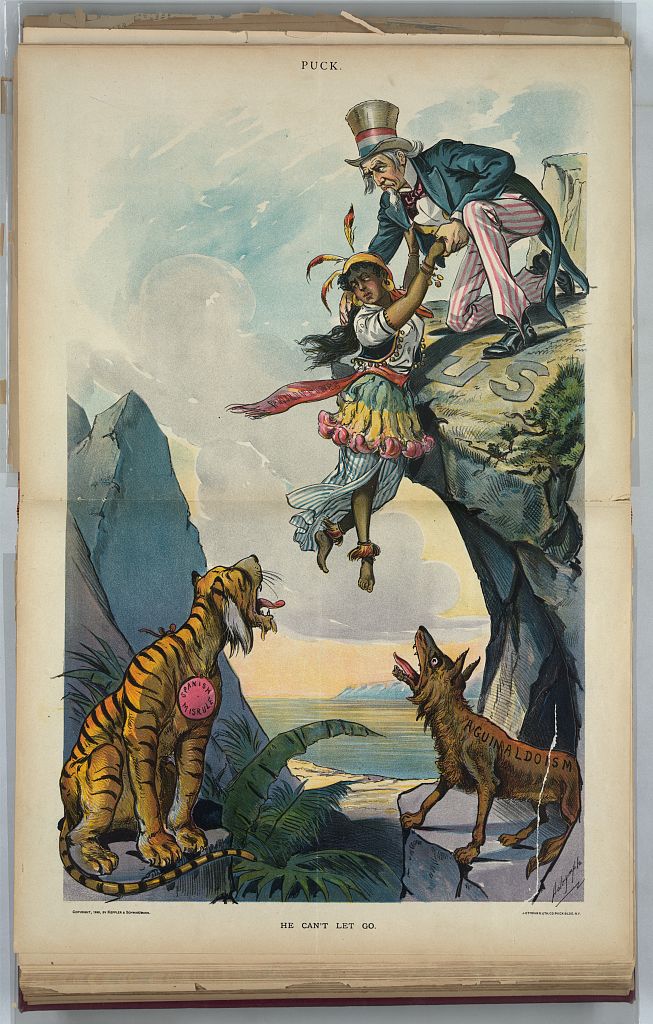
He Can’t Let Go
The image, “He Can’t Let Go,” by Louis Dalrymple is a symbolic representation of the American perspective on the Philippine-American War, which occurred from 1899 to 1902. The Philippine-American War emerged after the Spanish-American War, which were both outcomes of American imperialism. After the American Civil War, America believed themselves to be “a world power with global responsibilities and imperial ambition.”[1] Such ideology overall led to the Spanish-American War; before the war, Spain ruled over the Philippines, however, after Spain’s defeat, the political status of the Philippines was still left unresolved, thus giving America the idea to imperialize the Philippine islands so they can penetrate the markets of Asia.
The image, for the most part, portrays Uncle Sam holding a Filipino woman who is labeled “Philippines”. The woman is dangling over a cliff labeled “U.S.” and above a tiger and a wolf that are labeled “Spanish Misrule” and “Aguinaldoism”. Surely this image is meant to portray both the Spanish and Philippine government as a negative influence over the Filipinos, suggesting that the only thing that can save them is America. For the most part, the image is in favor of America, promoting the idea that American intervention was needed in order to “save” nations and its people. Overall, the picture was propaganda, for it promoted a specific and biased political point of view that aimed to convince and gain support from Americans.
As propaganda, the image fails to include the negative aspects of American imperialism. The image primarily represents the American perspective, meaning it fails to include the whole truth about the Philippine-American War. After Spanish rule, many Filipino’s wanted independence, so in 1899, they declared it and named Emilio Aguinaldo as their president. With that said, the image above seems to portray a false notion that Aguinaldoism was a threat to the Philippine Republic. However, to the Filipinos, Aguinaldoism was favored, for Emilio Aguinaldo was a loved, intelligent, and respected figure who people claimed to have led the Philippine Republic to their most glorious and significant epoch.[2] As Aguinaldo wanted independence, so did many Filipinos, which in fact contradicts the meaning of the picture, considering Aguinaldo aimed to fight for his people, not exploit and benefit from them as America intended to.
In addition to the false accusations of Aguinaldoism, the image above also fails to mention the war as cruel and unjust. In comparison to America, the Philippine Republic was, for the most part, inferior; not only did they lack supplies, but Filipinos were also poor marksmen. With that said, the image above can surely represent the difference between how warfare was practiced; the Filipinos practiced guerilla warfare, while the Americans practiced a conventional one, which overall shaped the idea that Filipinos were savages. In addition to the superiority of the U.S. Army, America was also able to convince some Filipinos by collaborating and negotiating with them. Filipino Historian, Renato Constantino, claimed that Aguinaldo additionally contributed to the American victory due to his lack of military intelligence and skill.[3]
Not only were the Filipinos viewed as militarily inferior, they were also viewed as racially inferior. The image above places America on a pedestal, for they disregarded the fact that they viewed and treated Filipinos as savages, similar to African Americans. During the war, U.S. troops burned villages, tortured and executed prisoners, imprisoned civilians in concentration camps, which overall killed numerous men, women, as well as children.[4] Surely this alters the meaning of the image; although Uncle Sam, or America, seems to be helping the woman, or Philippines, from falling off the cliff, in a Filipino’s point of view, this could also be interpreted as Uncle Sam as the aggressor who is trying to make the woman fall. By being viewed as racially inferior, the Philippine Insurgence was able to convince some African Americans to not only fight for the Filipinos, but also themselves; some African Americans even argued that “It is better to die fighting than become subject to a nation where a colored man is lynched and burned alive indiscriminately.”[5] The unity between the Filipinos and African Americans due to racism and discrimination from white Americans overall contradicts the message of the image; America depicts itself as “good”, however by unethical behaviors, and enforcing racism and discrimination, one simply cannot view America the same.
The image, “He Can’t Let Go” overall tells a one-sided story of the Philippine-American War that aims to only depict America as “good”, thus leaving out the negative aspects of American imperialism. However, it is still a significant image that explains what America was during the late nineteenth century and how they viewed countries like the Philippines. Such image is one of many images that are used as propaganda in order to gain support and approval from Americans. With that said, the overall message of the image revolves around American imperialism and the contradictions within their beliefs and actions.
Bibliography
Agoncillo, Teodore A. “General Aguinaldo in History.” Historical Bulletin (01163655), vol. 3, no. 1, Jan. 1959, pp. 7–14. EBSCOhost, search.ebscohost.com/login.aspx?direct=true&AuthType=sso&db=ahl&AN=46183949&site=ehost-live.
Kramer, Paul A. “Race-Making and Colonial Violence in the U.S. Empire: The Philippine-American War as Race War.” Diplomatic History, vol. 30, no. 2, Apr. 2006, pp. 169–210. EBSCOhost, doi:10.1111/j.1467-7709.2006.00546.x.
May, Glenn A. “Why the United States Won the Philippine-American War, 1899-1902.” Pacific Historical Review, vol. 52, no. 4, 1983, pp. 353–377. JSTOR, www.jstor.org/stable/3639072. Accessed 29 Mar. 2020.
Shi, David E. America: a Narrative History. W.W. Norton & Company, 2019.
[1] David Shi. America: A Narrative Story (W.W. Norton & Company, 2019), 819.
[2] Teodore A. Agoncillo. “General Aguinaldo in History,” Volume 3, Number 1 (1959): 14.
[3] Glenn A. May. “Why the United States Won the Philippine-American War, 1899-1902,” Volume 52, Number 4 (1983): 358.
[4] Shi, 832.
[5] Paul A. Kramer. “Race-Making and Colonial Violence in the U.S. Empire: The Philippine-American War as Race War,” Volume 30, Number 2 (2006): 180.
